#sewing machine history.
Note
Hey Pink,
so I went to a flea market today and scored a old singer machine for 10€! Now I'd like to know when it was made and probably where but I'm completely lost, maybe you could shed a little light on it?
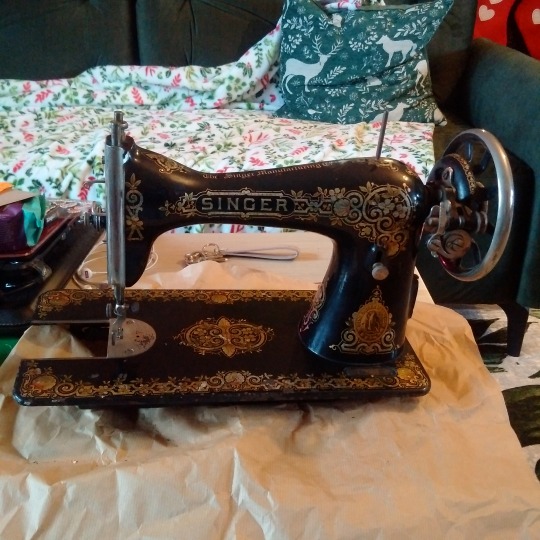

I cleaned the serial number plate as best I could. I suppose it reads: G67875 (2 or Z, I cannot tell)
Thank you so much!
It's a Model 15!
Here's some more information on the Model 15. Note that they're calling theirs the "15K", but the K just indicates that it was made in Scotland. Yours is likely a 15 and not a 15k, unless it says it was made in Great Brittan in the text along the top.
If you're ever unsure about the date on a Singer machine, I recommend this taxonomic key, and the Ismacs serial number database.
We can tell from the bobbin threading path on the front that this is a very early Model 15. According to the serial number, it's likely one of a lot of 50,000 made in January of 1910.
I believe the decal style on that is called Tiffany or Gingerbread. The first thing that I noticed about that is the absolutely exceptional state of those decals. Usually, machines of this age have a lot of the decal work worn off. If you want to clean them, be careful about damaging them.
The best advice I've found for cleaning and restoring old machines is from Doug at treadleon.net. Here's an excerpt from one of his articles:
Now let's talk about appearance. Some folks like to see an old machine shine like new. If the basic decoration, paint and decals, is good enough, that can be done. Most machines we find in sales aren't quite that good, or may actually be very bad. I like to let old machines show their age and usefulness. To clean a machine's surface, I use first a gentle mix of diluted dish soap and water, rubbing small areas at a time with a soft cloth. Often there is old dried oil or shellac on the surface. The earlier cleaning with kerosene may have loosened a lot of that up and it will rub off, too. Often it can be scraped off with a fingernail. Don't use hard scrapers, you'll scratch the enamel. Once I have the plain dirt off, I wipe with sewing machine oil several times over a period of days, then wipe off all the oil and wax. I use Turtle Wax. Other folks have had good luck with ArmorAll.
There are folks who favor various cleaning compounds, such as Simple Green, 409, Windex, etc. Great care must be exercised here. Many of the chemicals in these compounds, especially ammonia, will destroy the gold in the decals, leaving you with silver decals, or no decals. Since the decal content and manufacturing varied over the years and between manufacturers, the fact that a product did a great job on one machine does not mean it will not damage another. Always start by cleaning a small area in back of the pillar to see what is going to happen.
I've also found that liquid wrench spray penetrating oil can get through some really nasty dirt on the machines and it pretty decal-safe. It's become my main "clean now or else" tool for when dish soap is not doing the job fast enough.
One really cool fact about the Model 15 is that any time you're looking at sewing machine parts and you see the number 15, it's likely because it was a part first used in this machine. They use our standard needle, which is the needle family 15x1. If you go out and buy a standard sewing machine needle today, it will be a 15x1. When you go buy the standard bobbin for most Singer/Janome/Baby Lock/Brother/Bernette machines (plus some Pfaffs and Vikings), it's called the Class 15 bobbin. That's because the first machine to use these needles and these bobbins was the Singer Model 15. It's that influential.

The Model 15 sits flat on a table even without a bottom case, though you can buy some really nice bottom case reproductions on etsy or get a generic flatbed machine case from SewingPartsOnline if you do want a base for it. Note that if you use a generic case, you'll have to take the hand crank off when you store it with the lid on it. That said, I have my hand crank machine in a cheap generic flat bed case and it's always quite an enjoyment when someone opens it up and expects a mid-1990's machine and SURPRISE! It's an antique!!
Anyway, excellent find! The Model 15 was hugely influential. Pretty much any time that you find a modern sewing machine thing with the number 15 on it, it's because the item was first used on the Model 15. The needle family that all non-industrial sewing machines use today is the 15x1 needle family. That needle was first used on the Model 15. If you buy bobbins for almost any Janome/Brother/Baby Lock/Bernette and many Pfaffs and Vikings, it's called the Class 15 bobbin. That bobbin style was made for the Model 15 machine. I just think it's so cool that this machine became the standard so effectively that you can just go down to your local big box craft store and buy needles and bobbins for it!
PS if anyone wants a sewing-related rabbit hole to go down, Japanese Model 15 clones that are actually improvements on the Model 15 is a good one to check out. It was cloned long after Singer discontinued the Model 15.
96 notes
·
View notes
Note
I didn't know they had children's sewing machines back then too! That's so cute! Do you know what they would have cost at the time, compared to an adult-sized one?
Pretty much anything a mom would have/do around the house came in a miniature version for little girls - sewing machines, wash tubs/boards, little china cabinets full of dishes, tiny cast iron stoves, etc., etc.
As for cost - much less generally, but it's a little hard to compare as most children's machines were just the machine and were hand cranked, while adult machines usually came with a cabinet and many had switched over to electric power by that time.
Children's machines in the fall/winter 1923 Sears range from about $15 to $100 when adjusted for inflation.

Whereas a cabinet-less adult sewing machine would run you closer to $700 - however it was an electric machine, so again, hard to compare.

107 notes
·
View notes
Text
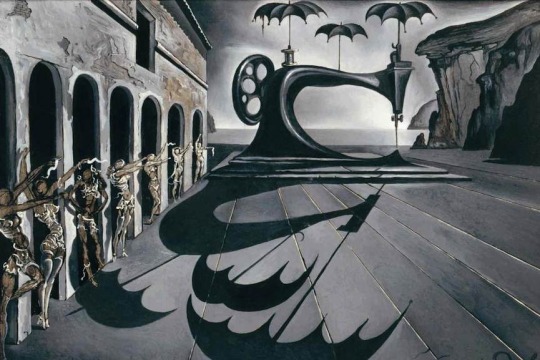
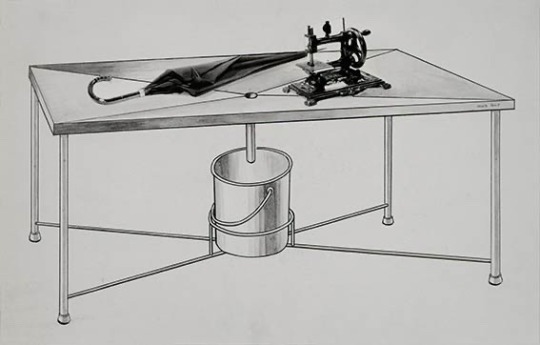




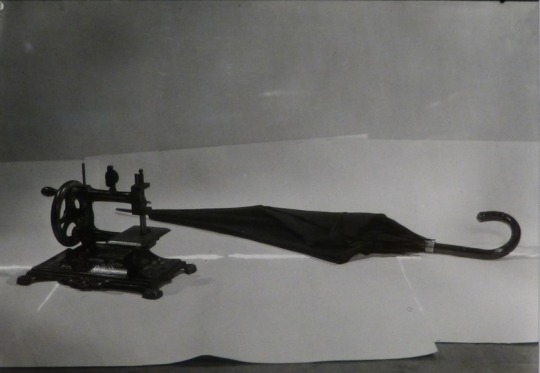

Salvador Dali, Sewing machine with umbrella I, 1941
Man Ray, Beau comme la rencontre fortuite sur une table de dissection d'une machine à coudre et d'un parapluie, (‘Beautiful as the accidental encounter, on a dissecting table, of a sewing machine and an umbrella’.) ca. 1933 (6 photos)
Salvador Dali, Detail- Sewing machine with umbrella I, 1941
#man ray#salvador dali#surrealist#surrealism#surrealist painter#surrealist photography#surrealist photographer#surrealist art#surrealist artist#spanish artist#american artist#sewing machine#umbrellas#modern art#art history#tumblr art#art on tumblr#aesthetic#beauty#tumblrpictures#tumblrpic#aesthetictumblr#tumblraesthetic
110 notes
·
View notes
Text
I love when people apply their subjects of study/work to a narrow part of tes lore. One of my favorite parts of this fandom
#learn new things AND engage with special interest!! what could be better!!!!!#anyway shout out to that soil post#and to the food posts i see form time to time#there is a phylogenetic tree and evolutionary history of the morrowind/skyrim beasties in my head that i need to put into the world someday#also i have an idea for unique soul gem powered and dwemer sewing machines but im not good enough at designed machinery for that#mine#tes#the elder scrolls#tesblr
42 notes
·
View notes
Text
I’m doing a thing… don’t know if it will work

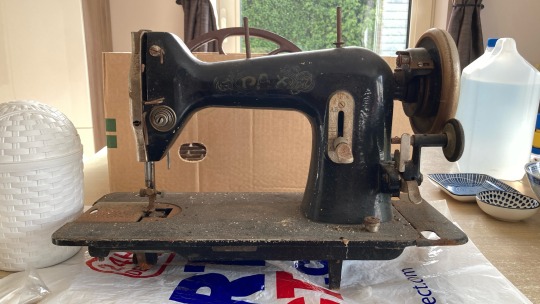
#archaeology#history#art#sewing machine#retro#vintage#vintage sewing machine#retro sewing machine#restauration
15 notes
·
View notes
Text
oh! It's September 10th!
Happy 176th anniversary to Elias Howe's lock stitch sewing machine patent!
222 notes
·
View notes
Text
i started taking a sewing class and i love it. so far i've made pillowcases, bucket hats, and handkerchief, and 2 toiletry bags. we have a lot more cool projects coming up like t-shirts, pajamas, crew neck sweaters, even rompers.
it's nice to have a hobby again, especially one that actually produces something that i can hold in my hands after. i love snipping the excess threads, i love turning my projects over in my hand and looking at stitches i did well, stitches i could have done better.
i love that i'm good at it, but not so good that i'm bored by it. i feel challenged, encouraged. my teacher is really excellent too.
i love that sewing is so permanent. i love combining fabric together in a way that is permanent, integral, fixed. i love eagerly pulling my project from my machine, i love examining my stitch and deciding whether i should keep going or tear it out and try again. i love that any stitch is undoable but you have to decide right after the stitch if you're going to undo it or not. i love that unsewing is always both possible and a pain in the ass.
i love the rhythmic pounding of the needle through the fabric. i love controlling the speed of the stitch with the pressure on my foot. i love the sensation of manipulating the fabric with my hands while the machine hammers in and out. i love that the fabric only needs to be flat where the needle is. i love moving and twisting the fabric so that the straight lines of the machine become circles and curves.
i love how much i get to use an iron.
i love taking flat parts and turning them into something three-dimensional. i love the combination of mindfulness and mindlessness. i love sewing.
#1000 bucket hats#sewing#machine sewing#i didn't even talk about my cool teacher#she's from albania and it's been so dope to learn about their culture and history from her
9 notes
·
View notes
Note
AITA for bribing small children with sharp objects so I could get pharmaceutical drugs?
I (29M) am NOT the asshole, but I’m making this post to prove a point to my “colleague” (it’s complicated) (26M) who says I’m ‘irresponsible’ and ‘acting unethically’ and should ‘stop giving needles to children because it’s so incredibly dangerous.’
Here’s the situation - him and I are doctors currently operating in a remote village where a highly infectious and extremely deadly plague has broken out. There is no known cure - except for one. The local children, for some godforsaken reason, like to raid mommy’s cabinet and steal antibiotics to play with. They grind these up and mix them together to create powders of mixed medicine. They cause irreversible damage to your liver and probably the rest of your body, they’re horrible, but they cure the goddamn plague.
I’m a doctor, like I said earlier, and it’s my job to take care of people. One of my other colleagues fell ill, with the plague, no less, and I needed to cure them. Badly. In order to get one of these powders, you do have to coax it out of the children with some bribery. And sometimes, all these children want is fifteen sewing needles and some walnuts you found on the ground. So that’s what I did.
Anyways I think the ends justify the means but my colleague doesn’t think so and is quite angry with me. He’s wrong, though, and also stupid. AITA??
#aita#am i the asshole#unreality#see this confuses me bc i learned how to use a sewing machine when i was 8 and up until very recent history it was super normal for-#-kids to do needlework
37 notes
·
View notes
Text
The link goes to the full playlist for all 3 videos, of the Vault Suit made Siren Suit, based on the Fallout game/tv series
The TV series comes out in April, and I'm interested to see what they do with it!
In the meantime, grab your Nuka Cola and Radaway, and crawl out through the Fallout with me!
#fallout#fallout 4#Fallout new vegas#Falloutnv#sewing#pattern drafting#siren suit#vault suit#fallout cosplay#historybounding#youtube#sewing machine#do it yourself#diy#cosplay#history#clothing#fallout 3#fallout games#fallout tv show#fallout amazon#fallout show#fallout series#fallout tv series#fallout tv
6 notes
·
View notes
Note
I was wondering if you would know how long would it take to make a dress for a ball in the 19th Century, before electricity was widely used. Like that was still a time when you went to a tailor to get your clothes made, especially for special occasions so... how much advance would you need? I'm guessing even longer if it's the tailor your friends go to as well and you are all going to the same ball, but on average, what? A week? With a trying test in between choosing the design and having it ready, I imagine...
Oh interesting question!
I've heard a week or two weeks as a turnaround time in contemporary sources from the late 19th century, when electricity had technically been harnessed but electric sewing machines (if they existed at all) were vanishingly uncommon
I imagine it helped speed things up if this was your regular dressmaker who already had measurements and custom-fitted patterns on file for you. even very wealthy women saw no issue with having multiple dresses made up from the same pattern with different fabrics and embellishments, back then. although, of course, the intricacy of the trimmings requested would factor into the production time as well
notably, before the infamous Bradley-Martin Ball of 1897, the hostess intentionally sent out invitations only three weeks in advance so that the guests wouldn't have time to order costumes from European couturiers and would have to patronize local dressmakers/tailors instead. so if a month or more was the lead time necessary for an imported fancy-dress costume, 1-3 weeks for something domestically made seems reasonable
(said hostess, Cornelia Bradley-Martin, saw this in the light of an economic stimulus to the garment workers of New York City. given that there was a recession on and the total cost of the ball ended up around $400,000- in 1897 dollars -the general public did not take such a charitable approach. there was massive outcry in the press and from the pulpit, and the city actually raised tax rates specifically for the Bradley-Martins and their friends the Astors, due to the astronomical excess of the ball. even the Victorians could at times be, as the youths do say, based. but I digress)
it's also important to keep in mind that most dressmakers did not work alone, but had a team of seamstresses working under them. so it wouldn't just be one woman struggling with a massive backlog of orders- these were usually multi-employee businesses, running like well-oiled machines to churn out handmade bespoke garments with impressive speed
...often criminally underpaid and with Not Great working conditions, but that's off-topic for the question at hand
#ask#motsimages#dress history#fashion history#victorian#victorian fashion#also they cut corners. shamelessly and wherever possible#SO MANY gorgeous Victorian bodices are unlined with raw edges just pinked and quickly tacked down#probably the majority I'd say#it's not going to touch bare skin and itch. nobody will see it. so who cares?#I've examined a Worth gown and the skirt trim is attached with massive gappy running stitches#once sewing machines came in the general way was Structural Seams By Machine; Hems By Hand#just like today they didn't want to make extra work for themselves#so even though they valued insanely fine stitching when it was visible#if it wasn't visible...
77 notes
·
View notes
Text

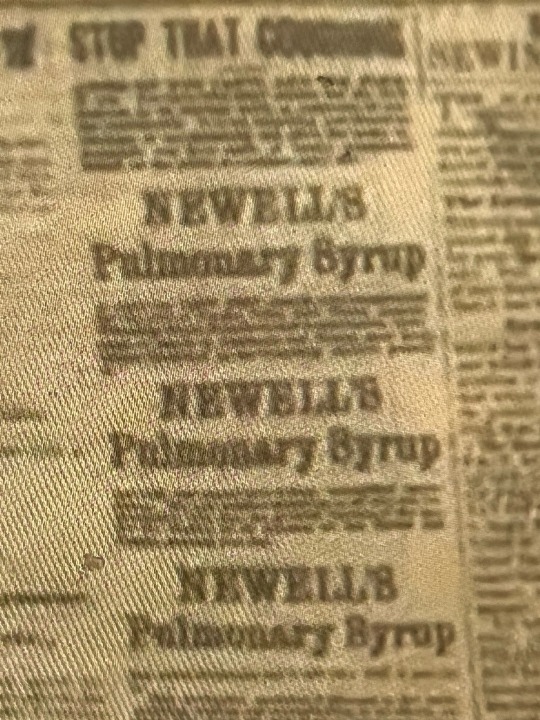
I just finished one piece La and I thought it was pretty good. Also so many details!!!!

Also singer sewing machines are now canon to one piece which means there is some Scotland based island with a Isaac singer somewhere in one of the blues.
#I’m also realizing how much of sewing machine history is specifically controlled by singer sewing machines#one piece#soup stuff#monkey d. luffy#one piece live action
12 notes
·
View notes
Text
hm I wonder if I can reuse my black ribbon that I bought really cheap on amazon and use it as decoration for my lady joker coat... thinking thoughts...
#I wanna try to put some fancy embroidery on it with my machine#let's see how it goes...#I hope the machine won't eat the ribbon#sewing#history bounding#coat#cosplay
4 notes
·
View notes
Text
someone take this device away from me i am much too tired to be dignified. pay this buffoon no mind.
#is that that word#much too#those are words#when i am sleep deprived i get rambly so thats what this is#please tune me out i will tired post and comment and tag and it is humiliating bc its not my true potential#i am better than this!#go to sleep!#nay#i shall keep on for some reason#old speech posting i guess. what era is this#shakespearean? early modern english? what era was that#anyway the Some Reason is boredom and need of sleep#i will continue to ramble stop laughing at me#bloop#ren faires are so fun even though they have like. nothing to do with the renaissance. im in the process of making a cape. sewing machine is#a bitch. why do i keep adding tags#fuck off stop looking at me#dont reply to this please spare me some pride#why did i even make this post#anyway i shoudl really be more educated on history#fuck what was i thinking about. bees?#no ren faires right#who wants to come with me that would be so fun. actually i have only been here for like 3 months and ive only dm’d a couple of you#and even then not a lot. but in my defense how tf do uou keep a conversation. how does that work i cant even do it in person#ive decided to cut myself off#bye
11 notes
·
View notes
Text
youtube
Absolutely charming 1987 documentary, remastered into HD, on how sewing machines work, their history, toy machines, and many other wonders.
You think you know how a sewing machine works. You probably don't :)
18 notes
·
View notes
Photo
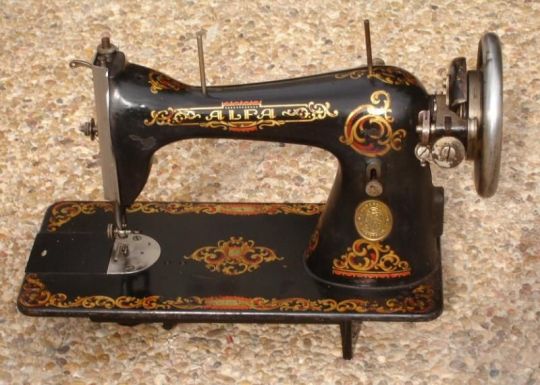
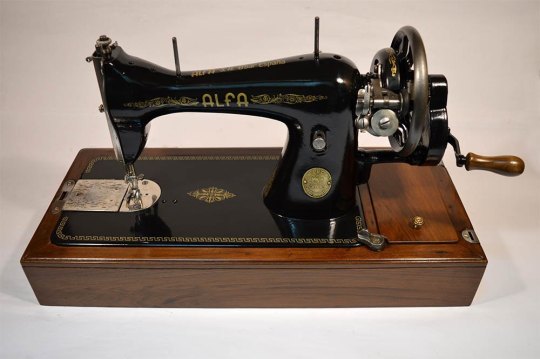

Some of the beautiful sewing machines from the 20s-30s, made by company Alfa in Eibar (Gipuzkoa).
Alfa has a unique history because it was one of the very first cooperatives in Spain. It started in 1920 making guns; in 1925 they started producing sewing machines that became so successful that by 1932 Alfa dedicated exclusively tot hem. In Spain, there was one of their models in almost every home. During WW2 their main competitor, German company Singer, was too busy making weapons, so Alfa started exporting their machines to Europe, producing 50,000 a year and selling to 70 countries.
What’s interesting of this cooperative was the socialist tone of its statutes. Their workers benefited from:
- Funds for social benefic purposes
- Funds for prevention and aid for the workers
- Cooperative housing
- Elementary schools
- Residence
- Library
- Dormitory
- Company store
- Summer camp for the kids
The socialist dream ended in the 80s due to the huge crisis that hit Euskadi that lead the cooperative to fall under a private company. Although they still make sewing machines that’s not their main business: Alfa was redesigned and focused on producing large weldless metal pieces.
Source
#euskadi#euskal herria#basque country#pais vasco#pays basque#eibar#gipuzkoa#alfa#cooperative#sindicalism#labor history#labor movement#sewing machines#history#culture
44 notes
·
View notes
Text
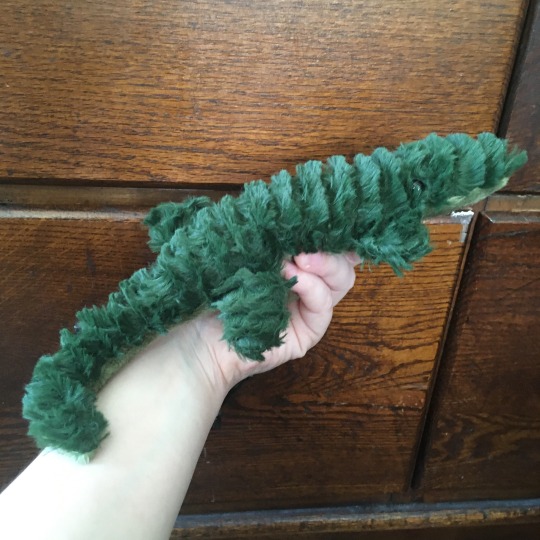


A little crocodile! He does not look much like a real crocodile, but he’s filled with polypellets and makes a really nice fidget toy
#sewing#handmade#plushie#crocodile#crocodile plushie#this crocodile is entirely handsewn#partially because I didn’t want to fight to use that dark green fabric with my sewing machine#partially because I just started watching puppet history and the entire thing was sewn while watching it lol#he is somehow so many good textures at once#I accidentally cut out his belly fabric with the nap going the opposite direction to the way I’d usually have it#but it’s better that way???? did not expect it#but it works really well with the backing fabric
32 notes
·
View notes